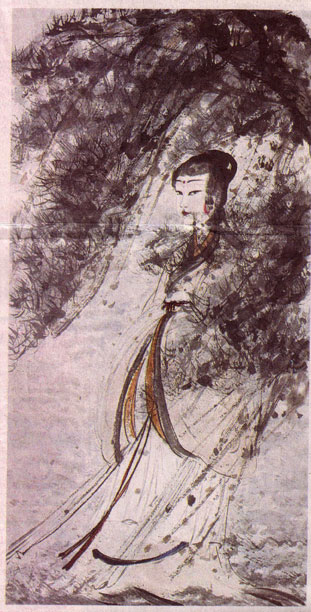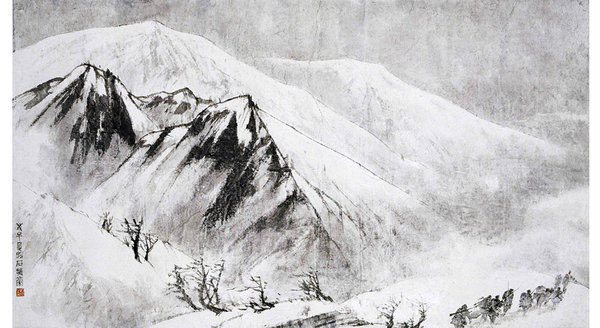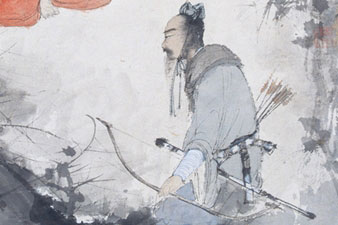~FU BAOSHI . . .
. . . this is what it feels like – to be a blogger.

Fu Baoshi’s ”Goddess Crossing the Xiang River’, an undated hanging scroll.
image from: THE NEW YORK TIMES, FRIDAY, JANUARY 27, 2012
you feel ethereal, as you move forward, you leave a trail not much more tangible than a series of wisps of smoke on the ‘web’ – a trail of smoke signals, a plume of brush strokes behind you. as you pass, like a transparent ghost . . . through the ever-bubbling human mind, plural.
there is no hard copy – the smoke signals exist only on the flutter and wind of the unseen wireless web . . . if this crashes, so does the info.
it is all about motion.
and so is this pen-and-ink brushwork . . . all about motion.
well, when you look at this Chinese painter’s work – these are the kind of thoughts that come to mind, even though the works are ‘realist’, as in earth-bound . . . they take off into the unknown and the divine – the timeless mysteries of mankind, looking backwards . . . while plotting the specifics of the here-and-now from which they spring.

FU BAOSHI, ‘The Far Snows of Minshan Only Make Us Happy’, (1951). image: NEW YORK TIMES
just dig – that small trail of soldiers along the bottom – right !!
the show at hand, titled ‘Chinese Art in an Age of Revolution: Fu Baoshi (1904-1965)’ just went up at the MET/Metropolitan Museum of Art, and ROBERTA SMITH gave it a wonderful write-up in this Friday’s (JAN 27, 2012) NEW YORK TIMES Weekend Arts section. not only does she lay-out the basic ‘geometry’ of the show, and the ‘history’ of the artist superbly – but in this case – she does so with that magic literary touch – that lets the artwork escape back into the ‘magic’ realm from whence they came. after all this is an artist who more than not, stamped his brushwork forays: “Often After Being Drunk.”
which is a lot like being on the web too. and, you are talking to who ? and you are reaching out into what ? and going where ?
and somehow it all adds up to a ‘realism’ – an aggregate collective consciousness greater than the parts. we used to be star gazers, now we are . . . web gazers.
I also really liked how the pen and ink brushwork of FU BAOSHI resonates with the brushwork of the contemporary young artists in the previous post, ELIJAH BURGHER and STEVE REINKE. from the paranormal, through the magic realism to the lyrical earth-based animal fables. from time immemorial man always picked up pen and brush to capture this world – but also to travel, to stretch the imagination and along the way, possibly, yes !! – open the pathways of knowledge . . . grabbing with inspiration and intuition the: just beyond – knowing. connecting the dots and following the bread crumb trails . . . to the future.
I also liked how she wrote about “Fu, a fervant devotee of the ancient tradition of Chinese brush-and-ink painting . . . often walked a kind of tightrope through the tumultuous times” of Chinese history from the 1911 Chinese Revolution, through the Sino-Japanese War of 1937-45, and finally through the aggressive Communist upheavals of the 40s. she continues: “His trajectory is the subject of an intriguing up-and-down survey. . . It suggests that Fu, who came from very humble circumstances and was largely self-taught, was sustained by exceptional talent and a steely yet flexible dedication to his art. His skill and refinement, as well as his willingness to adapt, pervade this show, which is serene on the surface but less so beneath.”
so much like the bi-polar survival instinct of the ‘spotted hyena’ – profiled immediate post below, or what.
FU BAOSHI’s struggles to retain the ‘magic’ realism of Chinese brushwork vs. the color-block literalism of Soviet-style ‘Social Realism’ – as Communist China played out – also receives an interesting mention in this article.
also of note: apparently the MET has so graciously brought us an under-hyped artist – as their first featured 20th century Chinese pen-and-brush master !! that’s so magic unto itself !!
though it’s also interesting to learn from Roberta that better-known figures, “like Fu’s contemporary ZHANG DAQIAN (1864-1957) or the elder QI BAISHI (1864-1983)” have made art world headlines recently, whose work “thanks to the enthusiasm and wealth of Chinese collectors, has ranked first and second in earnings at auction last year, above Warhol’s and Picasso’s.” (!!)
read: FU BAOSHI – ‘History Unfolding On A Hand Scroll’ by ROBERTA SMITH/NEW YORK TIMES – JAN 27, 2012

FU BAOSHI. detail . . . image c/o THE MET.
up-date: TUES JAN 31, 2012
yeah, and I know (!!) . . . my website crashed just mins after posting this. like they say in the comix: yikes !. and it wasn’t just my website – it was the entire server system that keeps it up – in the first place. so much for: no hard copy. talk about walking on a steely edge, and twirling like a plume of smoke.
